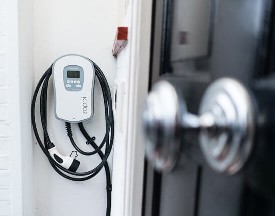November 27, 2024
In
The details:
- 16 Aiko 470W ABC Gen 2 Panels
- On Roof Mounting
- Bird Mesh
- GivEnergy 5kW Gen 3 Hybrid
- 9.5 kWh Battery (DC Coupled)
- 2 strings of 8 (left and right block)
- Myenergi Eddi
- Outdoor rated consumer unit
We install on many homes, day in, day out, and each one is special – for the carbon reduction it brings, the money it saves on energy bills, and the feeling of energy autonomy it gives. When there’s battery storage involved, there’s the reassurance of power during a power cut, and also the option to sell any excess energy back to the grid if you’re on a smart tariff. Installing a myenergi eddi, also means having the option to divert any excess straight to heating the water.
Decision making and answering questions
Our customer, Mary, first started investigating solar panels for her home over 3 years ago and this is her story. This is what Mary says about us:
“Joju came on my radar then. Family matters prevented me from continuing at that time, but when I came back to it, Joju were top of my list from everything I had read – including the ethos of the company.
The easy-to-understand quotes, product and installation information from Leo were of enormous benefit and gave me confidence in selecting Joju for the project. Leo was also great in answering all of my questions (however stupid) both quickly and helpfully”.
Installation and project management
It was great to get Mary’s feedback on the initial part of the process, and what about the experience of having solar, a battery and an eddi installed? Our installation team is always praised for highly skilled workmanship, tidiness and friendliness, but in her feedback, Mary really wanted to single out our project management:
“Ben as project manager was superb. His organisation and project management skills were beyond question. He kept me informed at every stage, and was friendly, informative, and responsive to queries immediately. He also helped me with a clear and full run through of the system and made sure I was happy with it before he left.
Ben also gave me confidence that as I learn the system and have queries, the after care will be readily available. My thanks go to the whole Joju team, and to Leo and Ben in particular, who were excellent.’
During an install, we know how important our installation team is and the quality of our workmanship. Afterall, we’ve been doing this for over 18 years. Mary’s feedback also goes to show just how important communication is too, and our project management team strive to make sure you’ll always be updated and assisted.
Post-installation
And what about Mary’s system now it’s installed? Mary says:
“The system is currently up and running happily and I am very happy with it. I would recommend Joju to anyone and I must say because the 16 panels span the whole roof at the back of the house they look superb.”
That’s what we love to hear. It was a pleasure installing on Mary’s roof to turn her home into a solar powerhouse. We’re so pleased she’s happy with the outcome.
If you’re looking for solar and battery storage for your home, please do get in touch. We’d absolutely love to help and bring our experience to your project.
Discover more
Contact us to get a quote for your residential solar project.
Read more about what we offer for your home.
Have a look at more of our case studies.












